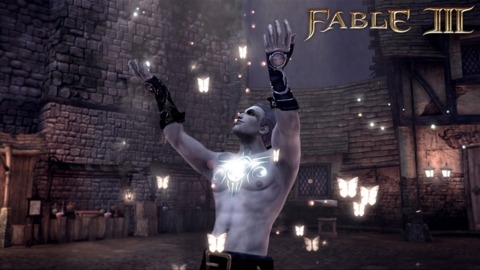Molyneux unveils Fable III Kingmaker mobile app
Lionhead boss Peter Molyneux announces Kingmaker mobile phone app and discusses Fable's various inspirations in a Fable III presentation at London's Eurogamer Expo.
Fable creator Peter Molyneux today unveiled Kingmaker, a Fable III tie-in mobile phone application. Kingmaker is a location-based check-in app similar to Foursquare that will divide players into two groups--rebels and loyalists--and pit them against each other in the run up to the launch of Fable III. Points and Fable gold are earned by checking into locations, with points determining the winning side and gold later being imported into players' Fable III games. "We'll see, by the time Fable launches, which side wins," said Molyneux.

"Every time you check in online, on the web or the mobile phone, you get Fable gold… I love the fact that people can make quite a bit of money, though not quite so much as people had in Fable II," Molyneux said, referring to an exploit in Fable II Pub Games that tied in to the full game.
The app will be available for Android and Nokia's Symbian phones from October 4, for the iPhone from October 6, and for Windows phones following the launch of Microsoft's new mobile operating system in late October or November.
The announcement came at the end of a presentation on the Fable series in which the Lionhead boss spoke about the genesis of the series and its various literary and cinematic inspirations. When the development of the original Fable began in 1998, Sleepy Hollow was a visual inspiration for Albion, he said, with Fable's gameworld aiming at a similarly dark fairy tale world grounded in reality. The legend of King Arthur was another inspiration, with the Lady in the Lake giving rise to the Fable mystical seer character, Theresa. The Picture of Dorian Gray, on the other hand, inspired Fable's character model morphing, with which the player's moral or immoral actions influence the appearance of the character model.
Molyneux also reminisced about lessons he learned about promoting his games to the press, saying that his claim that the first Fable was going to be "the greatest role-playing game of all time" was "the worst thing I ever said in my life." The bold claim was received sceptically and later derided, despite the game's largely positive reception. "I got into an awful lot of trouble," he admitted. Regarding one particular feature he had suggested to the press but that never made it into the game--an acorn that could grow into an oak tree over the course of the game--he said he "still can't understand why people were so excited about that."
Mad Max 2, he said, was the inspiration for Fable II's dog. He asked audience members to raise their hands if they had saved the dog and family at the end of that game, rather than the nameless thousands, and cited the high proportion of hands raised as evidence for how effective the dog was at forging an emotional bond with the player. Of the audience members who admitted they had started but not finished the game, he joked "seeing your hands up is like stabbing me in the heart."
Talking about Fable III's much-publicised touch system, in which the player interacts with other characters via context-sensitive touching, Molyneux singled out lauded PlayStation 2 title Ico as inspiration. "[Ico] breaks every single game design rule in the book, but had this wonderful mechanic in there for touch, with which the main character could reach out and touch this girl," he said, praising the emotional connection generated by that feature and saying the team had thought, "Why not just steal this mechanic?"
Got a news tip or want to contact us directly? Email news@gamespot.com
Join the conversation